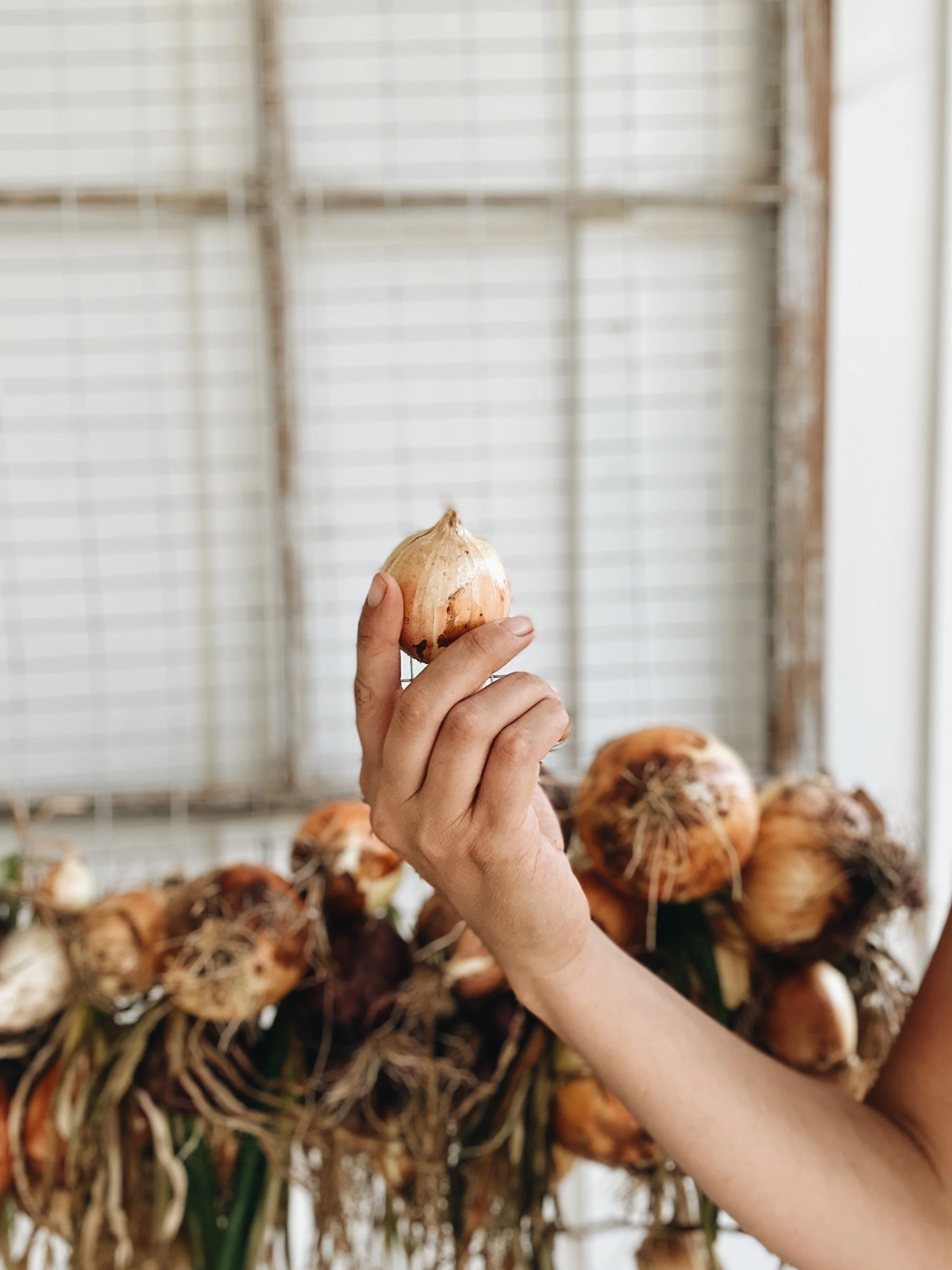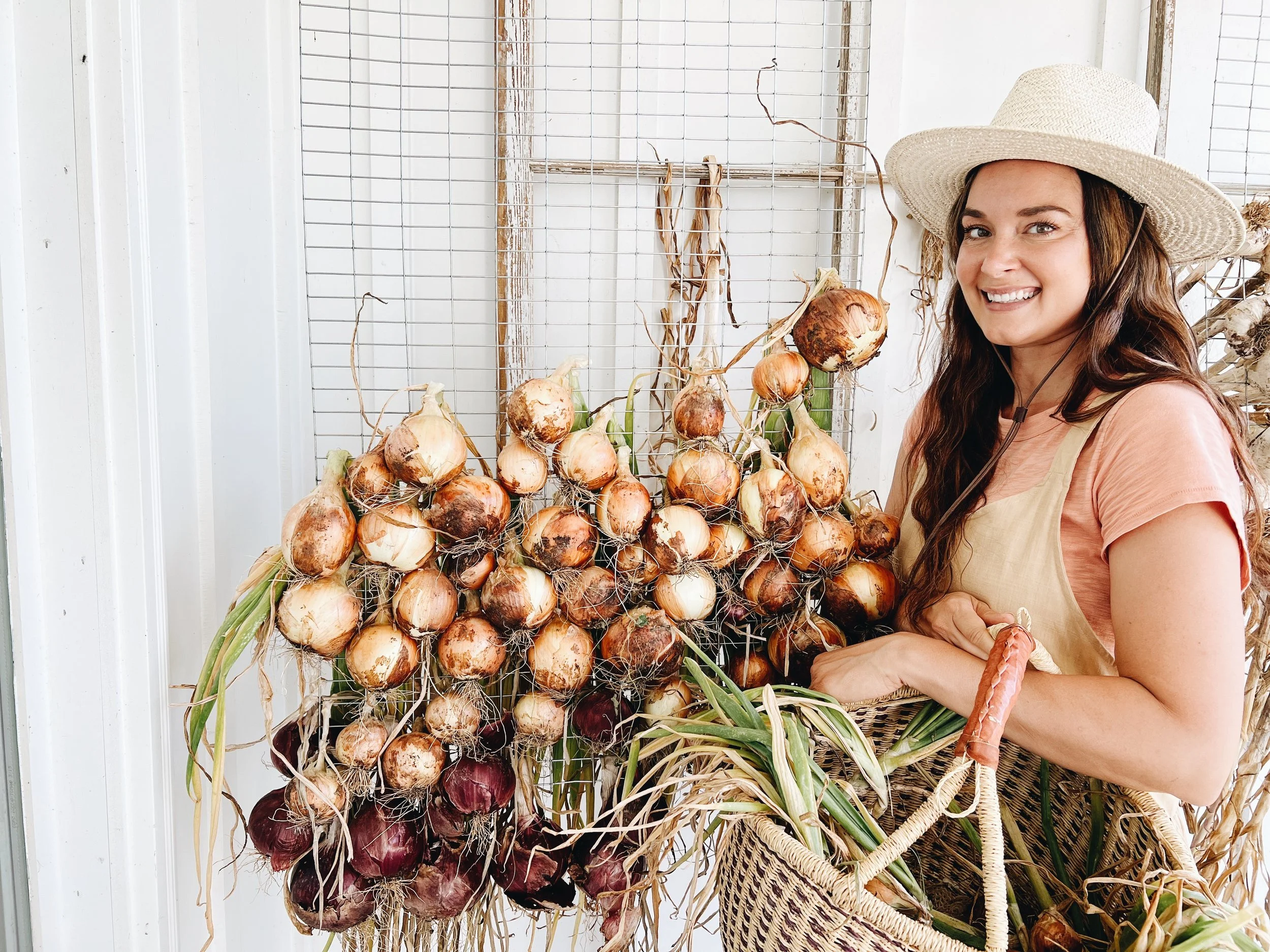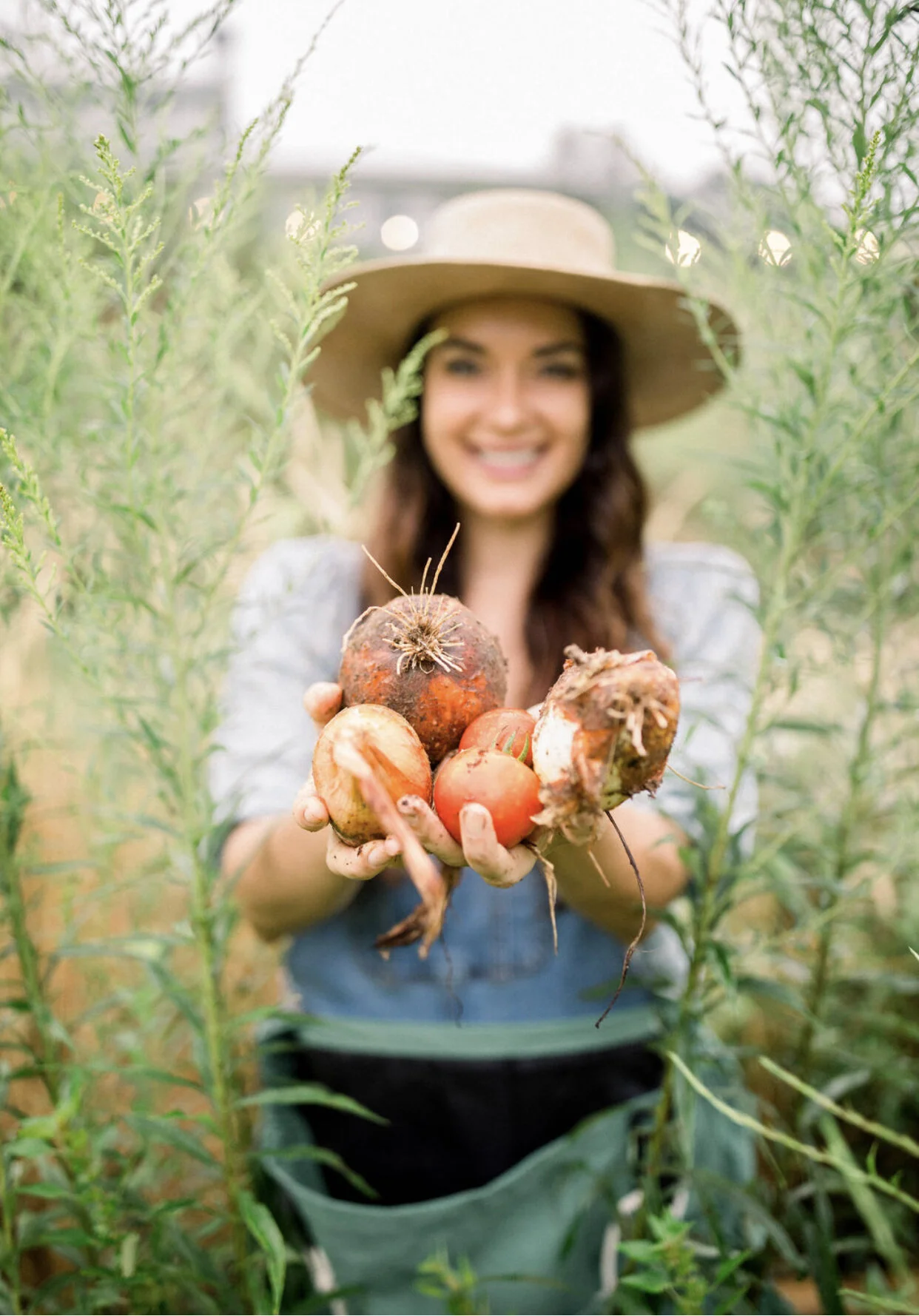How To Easily Grow Juicy Onions
Hold your tears; it's time to grow onions!
Onions are one of the many vegetables that can be planted in the fall and grow well through the winter into the spring.
This magnificent veggie is so versatile and an excellent staple to have in your garden patch. It can be used in various dishes, baked, grilled, fried, roasted, caramelized, or eaten raw. Ava loves them, too!
HOW TO GROW ONIONS
My favorite onions to grow are the sweeter varieties, such as Vidalia, which is native to my state, Georgia.
Sweet onions, with their higher sugar content, are perfect for sauteing, caramelizing, jams, and relishes. All of which I love to make!
Other types of onions include yellow onions, red onions, white onions, shallots, and scallions.
Whatever variety you choose, they all need the same steps and conditions (well, almost, depending on your zone) to grow into healthy, delicious, juicy plants.
3 categories of onions
Onions can be divided into 3 categories, and this will also determine which will grow best in your area:
Short-day onions
Need 10-12 hours of daylight
Perfect for mild climates, zones 7 and warmer (we are in zone 7b)
Planted in fall, mature in late spring
110 days in the South when planted in fall, and 75 days in the North when planted in spring.
Varieties include Vidalia, Georgia Sweet, Sweet Red, Texas Super Sweet, Texas Sweet White.
Did you know: The Vidalia onion is not a variety but instead named after the Vidalia region in Georgia where it grows. Sulfur gives onions their pungent flavor, but in Vidalia, the soil is low in sulfur, making the onion sweeter.
Day-neutral/ intermediate-day onions
Need 12-14 hours of daylight
Grows well in all regions, except South Florida and South Texas. Ideal for zones 5-6.
Planted in fall in mild winter climates and in early spring in northern regions.
Matures in 110 days.
Varieties include Spanish, Candy, and Cabernet.
Long Day Onions
Need 14-16 hours of daylight
Grows well in zone 6 and colder (Northern regions)
Planted early spring to harvest mid to late summer
90-110 days to mature
Varieties include Sweet Spanish, Walla Walla, Red Carpet, and Patterson.
when to plant onions
The best time to plant onions depends on your location and the specific variety of onions you're planting, as I mentioned above.
However, onions are typically planted in the early spring, as soon as the soil can be worked, or in the fall for overwintering varieties.
Spring planting
Spring planting will mostly be your long-day onions such as Sweet Spanish, Walla Walla, Red Carpet, and Patterson.
For spring planting, plant onions in late March to early April in colder climates and around February to end March in warmer climates.
Onions prefer cool weather and can tolerate light frosts, so planting them when the soil temperature reaches around 50°F (10°C) is ideal.
fall planting
Fall planting will be your short-day and day-neutral onions.
For fall planting, it's typically done in late summer to early fall, about 4-6 weeks before the first expected frost date. This allows the onions to establish their root systems before winter sets in.
Overwintering onion varieties are planted in the fall to produce early crops the following year.
Always refer to the specific planting guidelines provided with your onion seeds or sets, as they may vary based on your location and the variety you're planting.
Where to plant onions
choose a spot
Onions are relatively easy to grow and take up little space.
Plant them in a sunny spot in raised beds or rows.
Don't have a garden patch or ample space? No problem!
Plant them among your flowers or in a planter box or pot. Onions have shallow roots, so they don't require that much space to grow.
Soil requirements
Onions prefer well-drained soil that is light and fluffy, with no rocks and debris. A pH balance of 6-6.8 is ideal. Prepare your soil by applying fertilizer first, and do not plant in overly wet soil, as this can cause bulbs or seedlings to rot.
How to plant onions
seeds, seedlings, or sets
You can start growing onions in three ways - by seeds, seedlings, or sets (bulbs).
Seeds will take longer and may need to be started indoors, depending on the time of the year.
Seedlings are hardier and will cut growing time shorter, and sets are very tough and will cut growing time even more.
Tip: Place your onion seedlings or sets in some moist (not wet), loose starting mix, or potting soil about two to three weeks before you can set them outdoors. They will sprout and develop a good roots system for an early start.
Plant your seeds, seedlings, or sets 1 inch deep so that the roots are covered but not buried too deep.
If you plan to harvest some onions earlier (spring onions), space your onions 2 inches apart. And if you want your onions to grow into big, luscious, sweet bulbs, space them 4-6 inches apart.
How to grow onions
Water and Feed requirements
Onions are heavy feeders and drinkers.
Since their root system is very shallow, they need to be watered frequently. The soil should always be moist but not soaked.
When the plants start turning brown, you can water less, and when they bend over, stop watering altogether until you harvest them.
It will help your plants if you fertilize often with low sulfur and high nitrogen fertilizers, especially in spring when the bulbs start to form.
If you would rather grow organically without the use of fertilizer, you can top-dress your beds with high-quality nitrogen-rich compost every month.
Winter-hardy
Onions are generally winter-hardy and can handle frost and snow; they won’t die, but their growth will just slow down. However, If you experience temperatures below 20 degrees F for long periods of time, you need to cover them.
Invaders
Onions do not compete well with weeds, so keep your beds weed-free as much as possible. Adding mulch will help to keep the weeds at a minimum and your soil warm.
Lucky for us, most onions are resistant to pests, insects, and diseases. But look out for black onion thrips, aphids, and onion root maggots that can disturb the peace and wreck all your hard work!
Treat these problems as soon as you notice them.
Interesting Fact: Onions are often used as companion plants to deter pests away from crops such as cabbage, broccoli, cauliflower, beets, carrots, tomatoes, and strawberries. THIS blog post explains a bit more on how and why companion planting can benefit your garden.
How to harvest onions
Onions need, on average, 90 - 110 days to mature into lovely big bulbs. But, this does not mean that you can't harvest them earlier!
If you want spring onions or scallions, you can harvest them just a few weeks after planting. There is no perfect size that you have to wait for!
A long growth period is essential for full-sized bulbs and especially for yummy sweet onions. Allow the onions to grow and mature until the tops begin to turn yellow and fall over. Then, leave them in the ground for another seven days.
By this time, the anticipation has really built up, and you cannot wait to devour your onions! Pull them up, clean them of excess soil, and lay them in a sunny, dry spot to dry and cure with their tops still attached. The bulbs must stay dry and have good air circulation.
After 7 to 10 days, clip off the tops of the onions and the roots, gently clean the outer skins and store them in a cool, dry place.
Here is an in-depth article on How To Cure And Store Onions
It’s so wonderful to grow onions, as they can be used in so many recipes!! One of them being this delicious Sweet And Sour Onion Relish!
PIN FOR LATER
I hope this post has been helpful to you and given you some insight into growing onions! If you’re looking for more canning recipes this season take a look at my previous posts below!
Let me know if you make this recipe!
Warmly,
Annette
*Disclosure: This is a sponsored post that is part of an ongoing partnership with the Fresh Preserving Division of Newell Brands. They have provided jars, equipment and monetary compensation. All thoughts and opinions expressed are my own.








